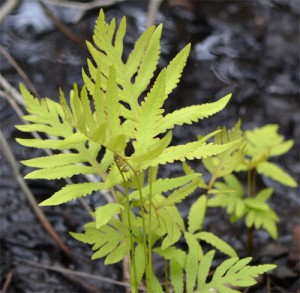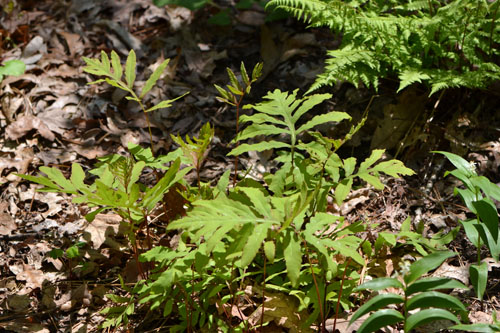 I have a few of these members of the Dryopteridaceae family in my woodland garden, among sessile bellwort and framing some oak and rhododendron. The plants have only been there for a year, and I’ve only seen the sterile fronds of this fern. The fern is also called bead fern because the fertile fronds that carry the spores look like beads on a stick. I am thinking that those will appear when the plants get a bit more established.
I have a few of these members of the Dryopteridaceae family in my woodland garden, among sessile bellwort and framing some oak and rhododendron. The plants have only been there for a year, and I’ve only seen the sterile fronds of this fern. The fern is also called bead fern because the fertile fronds that carry the spores look like beads on a stick. I am thinking that those will appear when the plants get a bit more established.
The more common name describes the fern’s tendency to wither at the first slight frost. This fern likes its feet wet – it grows on Cape Cod naturally in wet meadows and swampy land. Sensitive fern is also “sensitive” (ok, I could not resist) to drought, so you have to keep it moist. Acidic soil is preferred.
Sensitive ferns, which can get large, will add green and structure to any woodland garden. Do not remove the dead fronds of the sensitive fern until spring, as they provide protection over the winter.
The fiddleheads are apparently edible as well, but they are not as widely used or described as the fiddleheads of the ostrich fern. Maybe some caution is in order: Some sources mention the presence of carcinogens in parts of the plant. This fern also contains thiaminase, an enzyme that robs the body of its vitamin B complex. In small quantities this enzyme will do no harm, assuming a healthy and diverse diet. Additionally, cooking the fiddleheads removes the thiaminase.

| Scientific name: | Onoclea sensibilis |
| Common name: | sensitive fern |
| Other name: | bead fern, onoclea |
| Bloom time: | N/A |
| Color: | N/A |
| Light requirements: | sun to partial shade |
| Zone: | 3 to 8 |
| Soil: | acidic to neutral |
| Water: | moist |
| Origin: | North America east of the Rockies |
Hi, thanks for the writeup! Where did you find your info on the apparent edibility of the sensitive fern? I found similar info as taken from M. A. Weiner’s “Earth Medicine, Earth Food” but I’m curious where other info might have come from.
Thanks,
Steve
Hi Steve – I actually had this confirmed from a few sources – Rachel G. (or Mrs. G. as she likes to be referred to) – https://www.facebook.com/cookingwithmrsg as well as the Native American’s herbalist bible and PFAF (Plants for a Future) guide (can’t recall whether it was edible shrubs or another one in the series – I will take a look later) I have tried the fiddleheads. When I say edible that is all I would try on the fern, the chemical make up likely changes in mature fronds. Some other plants like Pokeweed are also only to be tried as a young shoot.
When it comes to these old global plant species you can also find good sources in European and Asian literature, as some of these ferns are to be found all across the northern hemisphere